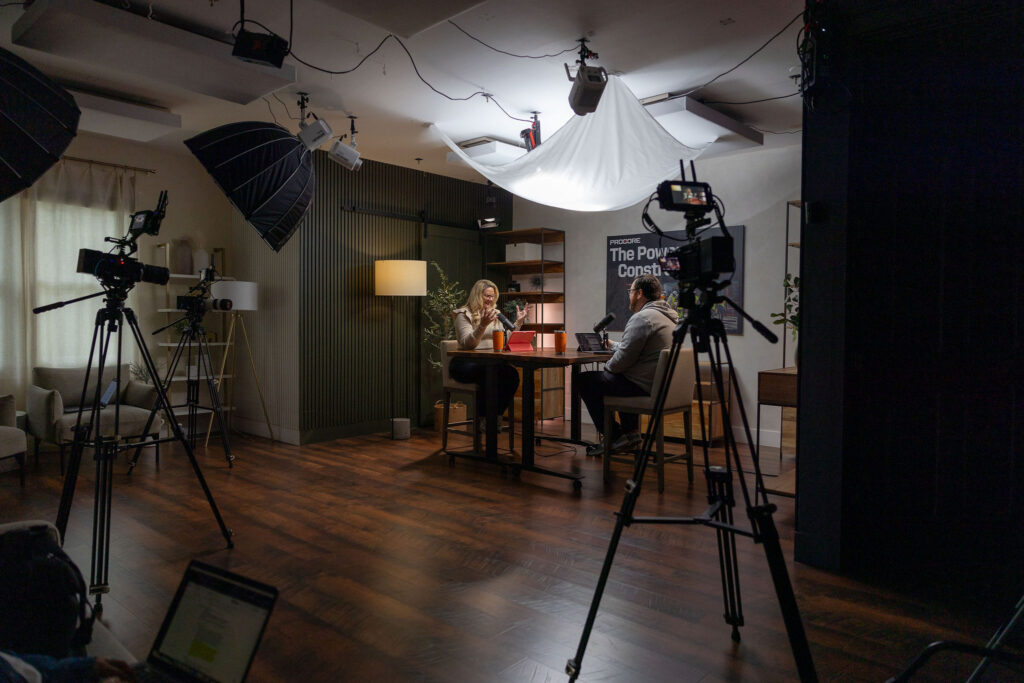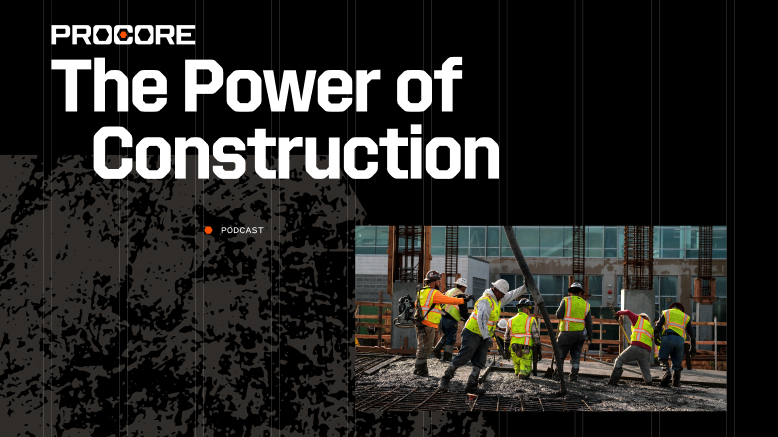What's Causing the Productivity Gap? A Season of Answers
In season one of The Power of Construction, we asked a big question: What's holding our industry back from boosting productivity? Across our conversations, we discovered that while the industry as a whole is fighting to overcome digital adoption, labor shortages, and other rapidly evolving challenges, there are leaders out there proving it can be done. In this special recap, hosts Sasha Reed and Kris Lengieza reflect on the insights they shared—and offer a preview of next season, where we'll step into a future where the power of construction is limitless.
Episode Transcript
The Decade-Long Vision Realized
Sasha Reed and Kris Lengieza open by sharing the personal story behind the podcast—a decade-long desire to democratize the "bar conversations" that happened after industry conferences. Those informal exchanges where innovators shared ideas, challenged assumptions, and learned from each other's successes and failures had been limited to those who could attend conferences.
The podcast represents their effort to bring those iron-sharpening-iron conversations to the broader industry, recognizing that innovation shouldn't be confined to chance encounters at the JW Marriott bar.
The Data Revelation: Abundance Yet Underutilization
One of the season's most significant revelations centered on data utilization. Despite fifteen years of technology adoption creating vast amounts of project data, the information remains largely unstructured and underutilized.
"We have everything we need. Now it's that next level of how are we organizing it? How are we structuring it? Where does it live in the business? Who's in charge of thinking about creating that data lake?" - Sasha Reed
This insight challenges the common narrative that construction lacks data. Instead, the industry has abundant data but lacks the organizational structures and cultural approaches to harness it effectively. Leaders are still waiting for ROI on technology investments because they haven't yet transformed raw data into actionable intelligence.
Innovation as Cultural Transformation
The season's conversations consistently revealed that successful innovation isn't primarily about technology adoption—it's about cultural transformation. The construction industry's traditional strengths of decisive leadership, grit, and perseverance remain valuable, but the current era demands additional capabilities: curiosity, willingness to test, and organizational resilience for experimentation.
This cultural shift requires moving beyond the "we've always done it this way" mentality to embrace data-driven decision-making while maintaining construction's core strengths. The most successful companies are those that blend traditional construction virtues with modern analytical approaches.
Todd Wynne: Obsession with Problems Over Solutions
Todd Wynne, Chief Innovation Officer at Rogers-O'Brien, provided one of the season's most quotable insights:
"Be obsessed with the problem. Be obsessed with the desired outcome. And if we live there, then we absolutely will move the needle."
This philosophy represents a fundamental shift from solution-first thinking to problem-first innovation. Wynne's approach demonstrates that successful innovation requires deep understanding of root causes before selecting tools or technologies.
This methodology has enabled Rogers-O'Brien to create a culture where innovation isn't confined to a single department but becomes organization-wide problem-solving capability. The key insight: young innovators and experienced practitioners must collaborate as co-creators rather than working in isolation.
Nancy Novak: Workforce as Innovation Driver
Nancy Novak, Chief Innovation Officer at Compass Datacenters, brought crucial perspective on the intersection of workforce diversity and innovation capability. Her standout observation:
"The workforce is the last thing AI is going to replace. And we are in a crisis of an aging workforce. We are in a crisis of a workforce that desperately needs to replenish itself and have that diverse perspective."
This insight reframes AI not as a job threat but as a tool that amplifies human capability, making diverse perspectives and interpersonal skills even more valuable. Compass Datacenters' success in achieving gender balance and attracting top talent stems from their recognition that complex problems require diverse thinking approaches.
They've solved recruitment challenges by positioning themselves as innovation leaders rather than traditional contractors.
Mike Rowe: The Eight Million Job Opportunity
Mike Rowe, Emmy-winning host of Dirty Jobs and founder of mikeroweWorks Foundation, provided stark perspective on construction's recruitment opportunity:
"We've got about eight million jobs that are currently open that don't require a four year degree. A lot of those jobs are in your industry, but they just don't get a lot of love."
Rowe's insights into Employee Stock Ownership Plans (ESOPs) revealed how ownership structures can create the entrepreneurial incentives needed to attract workers seeking both meaningful work and financial opportunity.
Jit Kee Chin: The People Side of Data Transformation
Jit Kee Chin, Chief Technology Officer at Suffolk Construction, brought this key insight:
"A lot of the real world change is driven by people. So how do you win hearts and minds? How do you set a direction? How do you get people to follow you? And then how do you systematically drive that organizational change?"
Despite being a data expert, Chin emphasized that technology success depends entirely on human adoption. Data can provide direction and analytical foundation, but transformation requires convincing people to change decision-making processes and embrace new approaches.
This highlights the critical importance of change management in any technological implementation.
The Statistical Reality Check
The season's opening episode with Peter Tateishi (CEO, AGC of California) and Josh Bone (Executive Director, ELECTRI International) provided sobering baseline statistics:
- Only 15% of projects are completed on schedule
- 30% finish on budget
- 10% achieve both schedule and budget targets
- $97 billion in costs is absorbed by subcontractors annually
- $40 billion is lost to productivity impacts
These numbers, while painful, establish crucial benchmarks for measuring improvement. Tateishi's framing of construction as "Industry One—the foundation upon which every other economy is built" provides the aspirational vision needed to drive transformation.
"Industry One. We are the first industry. We are the foundation upon which every other economy is built. And so we need to own that." - Peter Tateishi
Samantha Cook: The Evolving CFO Role
Samantha Cook, Chief Financial Officer at Brinkman Constructors, illustrated how executive roles are expanding to meet new challenges. Her evolution from traditional financial management to technology implementation, community engagement, and strategic market analysis demonstrates the leadership transformation required for construction companies to thrive.
Cook's "dream of a data lake" represents the next generation of construction executives who view technology not as a necessary evil but as a competitive advantage. Her approach to building internal buy-in by starting with projects outside her immediate domain shows the political savvy required for successful organizational change.
Jennifer Downey: ESG as Cultural Extension
Jennifer Downey, Director of Environmental Social Governance (ESG) at Turner Construction, demystified Environmental, Social, and Governance reporting by positioning it as cultural extension rather than compliance burden:
"ESG is really an extension of our culture. There are so many components of our culture that we're bringing together that have existed for a long time, sort of the fabric of who we are as an organization."
This perspective transforms ESG from check-box exercise to competitive advantage, particularly for recruiting purpose-driven workers. Turner's approach demonstrates how transparency and accountability can become recruitment tools when properly framed and authentically implemented.
Cornelius D. Griggs: Legacy-Driven Leadership
The season concluded with Cornelius D. Griggs, CEO of GMA Construction and 2025 Groundbreaker Award winner, whose approach exemplifies next-generation construction leadership. Despite being in his mid-thirties, Griggs thinks strategically about legacy:
"I hope that as leaders of organizations, we think about what our impact is gonna be when we're long gone from the industry. When you take your resources and you invest in these underserved communities across the country, that becomes a legacy."
Griggs' story represents the integration of profit and purpose that characterizes successful modern construction companies. His focus on rebuilding Chicago's inner cities—creating the infrastructure he wished he'd had growing up—has grown his company from $1 million to $100 million in revenue with a $400 million backlog.
Most remarkably, he reports no labor shortage issues because workers want to join purpose-driven projects.
Season One Synthesis: Key Insights
The inaugural season of The Power of Construction revealed that productivity gaps aren't inevitable industry characteristics but rather symptoms of specific, addressable challenges:
- Data Abundance, Insight Shortage: The industry has captured massive amounts of data but lacks organizational capability to transform it into actionable intelligence
- Cultural Evolution Imperative: Success requires blending construction's traditional strengths with modern analytical and collaborative approaches
- Leadership Role Expansion: Executive roles are evolving to encompass technology, community engagement, change management, and strategic transformation
- Purpose-Driven Differentiation: Companies that articulate clear social purpose and demonstrate positive impact attract better talent and achieve superior results
- Integration Over Replacement: Successful technology adoption enhances rather than replaces human capability and institutional knowledge
- Collaborative Advantage: Organizations that break down silos and encourage cross-functional problem-solving consistently outperform traditional hierarchical approaches
- Legacy Thinking: Leaders who consider long-term impact and community benefit create more sustainable, profitable, and attractive organizations
Looking Toward Season Two
The hosts tease that season two will focus on bringing expert minds together for discussions and debates about the industry's direction. Having identified root causes and highlighted successful approaches in season one, season two will explore the broader implications and potential futures for the construction industry.
"There are solutions here. The leaders we talked to about the headwinds of construction—the talent crisis, productivity gap, net new skills—they're solving those problems, and they're not experiencing the headwinds." – Sasha Reed
Key Takeaways for Construction Leaders
Season one demonstrated that productivity challenges are solvable through:
- Problem-First Innovation: Becoming obsessed with understanding challenges before selecting solutions
- Cultural-Technical Integration: Combining technology adoption with deliberate cultural transformation
- Data Organization: Moving beyond data collection to structured analysis and actionable insights
- Purpose-Driven Leadership: Articulating clear social impact to attract and retain top talent
- Collaborative Transformation: Breaking down traditional silos to enable cross-functional problem-solving
- Legacy Perspective: Making decisions based on long-term impact rather than short-term survival
- Inclusive Excellence: Recognizing that diverse perspectives and approaches drive superior outcomes
- Change Management Focus: Understanding that technology success depends entirely on human adoption
- Role Evolution: Adapting executive responsibilities to meet new challenges and opportunities
- Industry Pride: Embracing construction's role as "Industry One" while evolving methods to match that importance
The season's conversations prove that construction's productivity challenges aren't insurmountable obstacles but rather transformation opportunities for leaders willing to embrace change, invest in people, and think beyond traditional boundaries.





